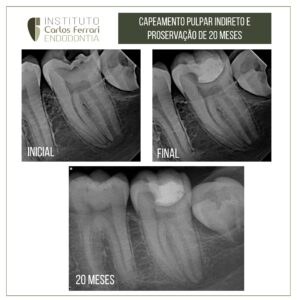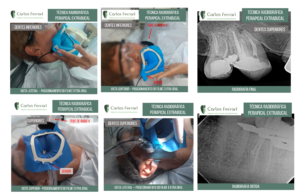RetRetratamento em dente com hipercementose.
Caso em que o dente foi retratado a pedido de colega, por tratamento estar aquém do ápice da raiz mesial.
Informou-se que o comprimento foi conferido pelo localizador, porém realizada nova tentativa a pedido do paciente.
Dessa vez tentou-se uma abordagem mais invasiva com alargamento foraminal, onde observou-se o trajeto do forame, longe da região apical aparente.
Caso conduzido pela aluna Ana Paula Santos da especialização em endodontia da Chibebe Cursos em Taubaté.
In: Nudera.Selective Root Retreatment: A Novel ApproachJ Endod 2015; 1–7.
Resumo
O retratamento do canal radicular é tradicionalmente considerado uma abordagem de tratamento “tudo ou nada”. É normalmente recomendado que todos os materiais restauradores e de obturação devem ser removido de todas as raízes, independentemente da presença ou ausência de patologia periapical. Ao contrário, a cirurgia a endodontia não é vista como um tratamento com abordagem “tudo ou nada”, Tradicionalmente, apenas a(s) raiz(es) doente(s) é(são) abordada(s) por meio de ressecção apical e obturação apical.
O uso da tomografia computadorizada de feixe cônico permite uma avaliação mais precisa da condição periapical de raízes individuais. Esta informação introduziu uma nova e conservadora alternativa de tratamento para dentes previamente tratados endodonticamente com múltiplas raízes apresentando doença pós-tratamento. Esta nova abordagem é denominada retratamento radicular seletivo. Imagem avançada permite ao clínico tomar decisões de tratamento previsíveis com relação à presença ou ausência de patologia periapical de raízes individuais, em vez de tomar suposições sobre o dente como um todo. Seletivo retratamento radicular combina a abordagem de tratamento não cirúrgico retratamento com a seletividade da ressecção cirúrgica da raiz. Desta forma, o retratamento pode ser limitado a uma única raiz ou raízes mostrando claramente a patologia periapical enquanto deixa a(s) raiz(es) sem nenhum sinal visível ou percebido patose intocada.
Retratamento em dente com hipercementose.





